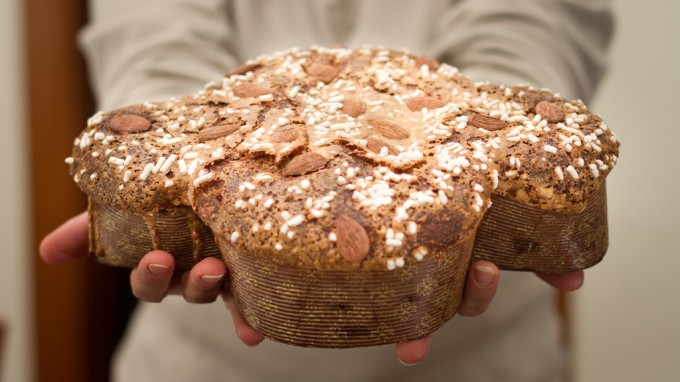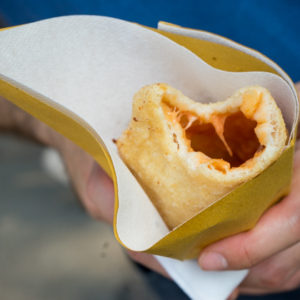
Pastiera (ricotta Easter tart)
Pastiera is a traditional Easter dish and is one of the most famous dishes in Naples. The story of its origin begins with a fairy tale, that the Neapolitans made offerings to mermaid named Partenope to thank her for her beautiful voice. They offered flour and orange blossom water to both symbolise the wealth of the land, the ricotta was offered by the shepherds, the eggs symbolise rebirth, the grain cooked in milk symbolises the union between the plant and animal kingdoms, the candied citrus fruit and spices represent foreigners abroad, and the sugar symbolises the sweetness of her voice. The mermaid mixed the offerings together and created pastiera. Wheat berries were also sacred to Demeter (the Greek goddess of harvest) as they were symbols of fertility (spring). Jesus’s tomb was decorated with wheat berries in the days before Easter.

Colomba di Pasqua by Nicola
Other traditional Italian Easter dishes include:
- torta pasqualina (chard and ricotta Easter tart) from Liguria
- abbacchio al forno (roast lamb with garlic and rosemary) from Lazio
- Colomba (a dove-shaped sweet bread flavoured with candied citrus peel and topped with almonds and sugar) from Lombardia
- Gubana (a snail-shaped brioche or puff pastry filled with chopped nuts, raisins, lemon zest and grappa) from Friuli
- casatiello (cheese, salami and pork rind bread with whole eggs in their shell baked into the crust) from Campania
- cassata (sponge cake layered with sweetened ricotta flavoured with candied fruit and chocolate) from Sicilia
- pardulas (ricotta tarts) from Sardegna
- pizza di Pasqua (a fluffy sweet bread flavoured with orange and lemon) from Umbria and Lazio
To see a related Easter post on Italian traditions, click here.
Recipe:
Pastiera Napoletana (Easter ricotta pie)
Serves 12
Dolci (Dessert)
From Campania
Some people like to make this dish 2-3 days in advance and leave it in a box to let it the flavour develop. This is of course only possible if you live somewhere temperate and dry. For illustrated step-by-step instructions, click here.
Pastry:
600 grams plain flour or “00” flour, plus 1 tablespoon
300 grams caster sugar
1 lemon, zested
300 grams butter, unsalted, cut up, plus more for greasing the pan
1 egg, beaten
1 egg white
Filling:
200 grams of soft white wheat berries or 1 can of cooked wheat (grano cotto) available at specialty Italian food shops
500 mls whole milk
200 grams sugar plus 1 tablespoon
1 teaspoon ground cinnamon plus 1 pinch
1 vanilla bean, sliced open and beans scraped out, bean reserved or 1 1/2 teaspoon vanilla extract
500 grams ricotta
6 eggs, carefully separate the white from the yolk and keep in separate containers covered with cling film until room temperature
30 mls orange flower water
1 orange zested
1 lemon, zested
150 grams candied citrus peel
1 pinch of salt
1 tablespoon confectioner’s sugar
1. If you are using tinned wheat, skip to step 3. Four days before you want to make the pastiera, place the wheat berries into a bowl and cover with cold water and place in the refrigerator. For four days, change the water every day. On the fourth day make the pastiera.
2. Start by greasing a 26 cm spring form tin with butter and sprinkling flour into the pan to coat the pan. Tip out the rest of the flour and discard.
3. Drain the wheat from the water and placing it (or by placing the contents of the tinned wheat) into a saucepan with the milk (if you are using tinned wheat then use only 250 ml milk), 1 tablespoon of sugar, pinch of cinnamon, and vanilla seeds and pod. Bring the mixture to a simmer over medium heat and then turn to low and let cook for 2 hours (if you are using tinned wheat, then only cook for 30 min.) Stir the mixture frequently so the mixture does not stick to the bottom of the pan. It is done when the it is creamy, the milk is absorbed, and the wheat is soft and swollen. When it is done, allow it to cool to room temperature.
Meanwhile you can start making the pastry, you can either use a food processor or make it by hand. If you use a food processor, add the butter and sugar to the machine and pulse to combine. Add the lemon zest to the machine and pulse until combined. Add the egg and pulse to combine. Finally add the flour, pulsing until you can form a ball.
If you are mixing the pastry by hand, add the butter and sugar stirring to combine. Add the lemon zest to combine. Add the egg and stir to combine. Add the flour just until combined.
Place the mixture on a sheet of cling film, pressing down to form a disc. Refrigerate for 30 minutes.
Heat the oven to 180 C. Break the pastry dough into two with one part twice the size of the other part. Roll out the pastry on a sheet of parchment paper to 5 mm thick and line the bottom and sides of the pan with it, peeling off the parchment paper. If the pastry breaks it is not a problem, just patch it with other pieces of dough. Place a new piece of parchment over the top and place the dough in the freezer for 30 minutes.
Meanwhile roll the rest of the pastry on parchment paper in an oblong or rectangular shape. Use scissors to cut the pastry and the paper together in 2 cm wide strips. Re-frigerate the strips.
Remove the tin from the freezer and place beans, rice, lentils, or pie weights on top of the parchment paper to fill the tin. Place the tin in the oven for 12 minutes. Re-move the tin and pick up the paper to remove the beans. Brush the pastry with egg white and place back in the oven for 3 minutes. Remove the tin and allow it to fully cool.
While the tin is cooling, whip the ricotta in an electric mixer on medium speed for 5 minutes. If you don’t have an electric mixer then press through a fine mesh sieve and beat the ricotta by hand for 10 minutes until creamy. Add 6 egg yolks, mixing in one at a time ensuring that one is incorporated before the next is added. Add the orange flower water, orange and lemon zest, the candied citrus peel, 1 teaspoon of cinna-mon, and 200 grams of sugar to the ricotta. Remove the vanilla bean from the wheat mixture and stir in the ricotta mixture. In a separate clean bowl, put in 6 egg whites with a pinch of salt. Whip the egg whites in an electric mixer or by hand with a whisk until it forms stiff peaks. If you are using an electric mixer, mix it on medium slow to slowly build up the air. It should take about 15 minutes. Take a large spoonful of the egg whites and add to the wheat mixture, stir to combine thoroughly. Add the rest of the egg whites and fold in gently to ensure you keep all the air you have whipped into the egg whites. Pour the contents into the cooled pastry.
Take the strips of pastry out of the refrigerator and start laying strips across the pie, peeling the paper off as you lay it. Lay the strips so that it forms diamonds across the top of the pie and weaving them in and out.
Place the pie in the oven for 75 to 90 minutes or until it is golden on top and a tooth-pick inserted in the centre comes out clean. The pie may still jiggle a little even when the toothpick comes out clean. If the top is browning too much then cover it with a sheet of aluminium foil. When the pie is done, remove it from the oven and let it cool on a wire rack. Before serving, add the confectioner’s sugar to a fine wire mesh and sprinkle the sugar evenly over the pie to serve.






Leave a Reply